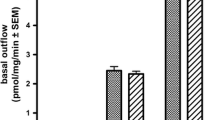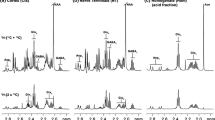Abstract
Using very low concentrations (1 μmol range) ofl-2-3-[3H]glutamate, (3H-Glu) orl-2-3-[3H]glutamine (3H-Gln), we have previously shown by autoradiography that these amino acids were preferentially taken up in the molecular layer of the cerebellar cortex. Furthermore, the accumulation of3H-Glu was essentially glial in these conditions. We report here experiments in which uptake and metabolism of either (3H-Glu) or (3H-Gln) were studied in adult rat cerebellar slices. Both amino acids were rapidly converted into other metabolic compounds: after seven minutes of incubation in the presence of exogenous3H-Glu, 70% of the tissue accumulated radioactivity was found to be in compounds other than glutamate. The main metabolites were Gln (42%), α-ketoglutarate (25%) and GABA (1,4%). In the presence of exogenous3H-Gln the rate of metabolism was slightly slower (50% after seven minutes of incubation) and the metabolites were also Glu (29%), α-ketoglutarate (15%) and GABA (5%). Using depolarizing conditions (56 mM KCl) with either exogenous3H-Glu or3H-Gln, the radioactivity was preferentially accumulated in glutamate compared to control. From these results we conclude: i) there are two cellular compartments for the neurotransmission-glutamate-glutamine cycle; one is glial, the other neuronal; ii) these two cellular compartments contain both Gln and Glu; iii) transmitter glutamate is always in equilibrium with the so-called “metabolic” pool of glutamate; iv) the regulation of the glutamate-glutamine cycle occurs at least at two different levels: the uptake of glutamate and the enzymatic activity of the neuronal glutaminase.
Similar content being viewed by others
References
Young, A. B., Oster Granite, M. L., Herndon, R. N., andSnyder, S. H. 1974. Glutamic acid: selective depletion by viral induced granule cell loss in hamster cerebellum. Brain Res. 73:1–13.
McBride, W. J., Aprison, M. H., andKusano, K. 1976. Contents of several aminoacids in the cerebellum, brain stem and cerebrum of the “staggerer”, “weaver” and “nervous” neurologically mutant mice. J. Neurochem. 26:867–870.
Hamberger, A. 1971. Aminoacid uptake in neuronal and glial cell fractions from rabbit cerebral cortex. Brain Res. 31:169–178.
Henn, F. A., ANDHamberger, A. 1971. Glial cell function: uptake of transmitter substances. Proc. Natl. Acad. Sci. (USA) 68:2686–2690.
Van der Berg, C. F., andGarfinkel, D. 1971. A simulation study of brain compartments—metabolism of glutamate and related substances in mouse brain. Biochem. J. 123:211–218.
Balazs, R., Machiyama, Y., andPatel, A. J. 1972. Compartmentation and the metabolism of γ-aminobutyrate. Pages 57–70,in Balazs, R., andCremer, J. E. (eds.), Metabolic Compartmentation in the Brain, McMillan Press, London.
Henn, F. A., Goldstein, M. N., andHamberger, A. 1974. Uptake of neurotransmitter candidate glutamate by glia. Nature (Lond.) 249:663–664.
Benjamin, A. M., andQuastel, J. H. 1975. Metabolism of aminoacids and ammonia in rat brain cortex slices in vitro: a possible role of ammonia in brain function. J. Neurochem. 25:197–206.
Hertz, L. 1979. Functional interactions between neurons and astrocytes. I. Turnover and metabolism of putative aminoacid transmitters. Prog. Neurobiol. 13:277–323.
Schousboe, A. 1981. Transport and metabolism of glutamate and GABA in neurones and glial cells. Int. Rev. Neurobiol. 22:1–45.
Shank, R. P., andAprison, M. H. 1981. Present status and significance of the glutamine cycle in neural tissues. Life Sci. 28:837–842.
Garthwaite, J., andBalazs, R. 1981. Separation of cell types from the cerebellum and their properties. Pages 461–467,in Fedoroff, S., andHertz, L. (eds.) Advances in Cellular Neurobiology. Vol. 2, Academic Press, New York.
Campbell, M. L., andShank, R. P. 1978. Glutamate and GABA uptake by cerebellar granule and glial cell enriched populations. Brain Res. 153:618–622.
de Barry, J., Langley, O. K., Vincendon, G., andGombos, G. 1982.l-glutamate andl-glutamine uptake in adult rat cerebellum: an autoradiographic study. Neurosci. 7:1289–1297.
Hamberger, A., Han Chiang, G., Nylen, E. S., Scheff, S. W., andCotman, C. W. 1979a. Glutamate as a CNS Transmitter. I. Evaluation of glucose and glutamine as precursors for the synthesis of preferentially released glutamate. Brain Res. 168:513–530.
Yamamoto, C., andMcIlwain, H. 1966. Electrical activities in thin sections from the mammalian brain maintained in chemically defined mediain vitro. J. Neurochem. 13:1333–1343.
Lowry, O. H., Rosebrough, N. J., Farr, A. L., andRandall, R. J. 1951. Protein measurements with the folin phenol reagent. J. Biol. Chem. 193:265–275.
Zanetta, J-P., Vincendon, G., Mandel, P., andGombos, G. 1970. The utilisation of 1-dimethyl-aminonaphtalene-5-sulphonyl chloride for quantitative determination of free aminoacids and partial analysis of primary structure of proteins. J. Chromatogr. 51:441–458.
Baldessarini, R. J., andYorke, C. 1974. Uptake and release of possible false transmitter aminoacids by rat brain tissue. J. Neurochem. 23:839–848.
Hertz, L., Yu, A., Svenneby, G., Kvamme, E., Fosmark, H., andSchousboe, A. 1980. Absence of preferential glutamine uptake into neurons—an indication of a net transfer of TCA constituents from nerve endings to astrocytes? Neurosci. Lett. 16:103–109.
Norenberg, M. D. 1979. the distribution of glutamine synthetase in the rat central nervous system. J. Histochem. Cytochem. 27:756–762.
Wilkin, G. P., Garthwaite, J., andBalazs, R. 1982. Putative acidic aminoacid transmitters in the cerebellum. II. Electro microscopic localization of transport sites. Brain Res. 244:69–80.
Patel, A. J., Hunt, A., Gordon, R. D., andBalazs, R. 1982. The activities in different neural cell types of certain enzymes associated with the metabolic compartmentation of glutamate. Dev. Brain Res. 4:3–11.
Balcar, V. J., andHauser, K. L. 1978. Transport ofl-[3H]glutamate andl-[3H]glutamine by dissociated glial and neuronal cells in primary culture. Page 498,in Neuhoff, V. (ed.), Proc. Europ. Soc. Neurochem. Vol. 1, Verlag Chemie, New York.
Schousboe, A., Hertz, L., Svenneby, G., andKvamme, E. 1979. Phosphate activated glutaminase activity and glutamine uptake in astrocytes in primary cultures. J. Neurochem. 32:943–950.
Weiler, C. T., Nyström, B., andHamberger, A. 1979. characteristics of glutamine vs glutamate transport in isolated glia and synaptosomes. J. Neurochem. 32:559–565.
Ramaharobandro, N., Borg, J., Mandel, P., andMark, J. 1982. Glutamine and glutamate transport in cultured neuronal and glial cells. Brain Res. 244:113–121.
Bradford, H. F., andWard, H. K. 1976. On glutaminase activity in mammalian synaptosomes. Brain Res. 110:115–125.
Berl, S., Lajtha, A., andWaelsch, H. 1961. Aminoacid and protein metabolism. VI. Central compartmentation of glutamic acid metabolism. J. Neurochem. 7:186–197.
Benjamin, A. M., andQuastel, J. H. 1972. Locations of aminoacids in brain slices from the rat. Biochem. J. 128:631–646.
Foster, A. C., andRoberts, P. J. 1980. Endogenous aminoacid release from rat cerebellum in vitro. J. Neurochem. 35:517–519.
Flint, R. S., Rea, M. A., andMcBride, W. J., 1981. In vitro release of endogenous aminoacids from granule cell-, stellate cell- and climbing fibres deficient cerebella. J. Neurochem. 37:1425–1430.
Schousboe, A. 1977. Differences between astrocytes in parimary cultures and glial cell lines in uptake and metabolism of putative aminoacid transmitters. Pages 441–446,in Fedoroff, A., andHertz, L. (eds.) Cell. Tissue and Organ Cultures in Neurobiology, Academic Press, New York.
Bradford, H. F., Ward, H. K., andThomas, A. J. 1978. Glutamine, a substrate for nerve endings. J. Neurochem. 30:1453–1459.
Hamberger, A., Han Chiang, G., Sandoval, E., andCotman, C. W. 1979. Glutamatee as a CNS transmitter. II. Regulation of synthesis in the releaseble pool. Brain Res. 168:531–541.
De Belleroche, J. S., andBradford, H. F. 1972. Metaolism of beds of mammalian cortical synaptosome. Response to depolarizing influences. J. Neurochems. 19:585–602.
Author information
Authors and Affiliations
Rights and permissions
About this article
Cite this article
de Barry, J., Vincendon, G. & Gombos, G. Uptake and metabolism ofl-[3H]glutamate andl-[3H]glutamine in adult rat cerebellar slices. Neurochem Res 8, 1321–1335 (1983). https://doi.org/10.1007/BF00964001
Accepted:
Issue Date:
DOI: https://doi.org/10.1007/BF00964001




